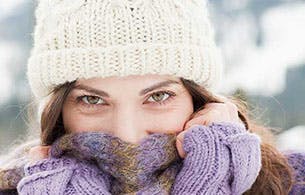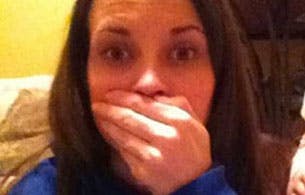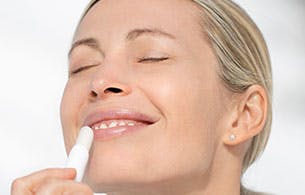Back to Dealing with Cold Sores articles
What Are The Stages of a Cold Sore?
A cold sore can ruin your mood and knock down your confidence. These unsightly blisters on your lip or mouth, sometimes called fever blisters , can take up to 10 days to clear up on their own.3 Recognizing the beginning stages of a cold sore, even before the blister appears, help you minimize discomfort and speed up healing at each stage. Abreva® Cream can reduce how long your cold sore lasts, and Abreva Rapid Pain Relief helps relieve your pain from the first use until your cold sore heals.
Keep reading to discover the typical cold sore stages, so you can understand the process from the first tingle to when it’s fully healed.
TIP
Always keep a tube of Abreva® Cream with you so you can apply it at the first sign of cold sore. For best results, apply five times a day.
* Median healing time 4.1 days. 25% of users healed in 2½ days.
Beginning Stages of a Cold Sore
Stage 1: Telltale Tingling
The beginning of a cold sore is known as the “prodrome” stage and usually lasts from several hours to a couple of days.3 You'll feel a tingling, itching, or burning sensation on your lip, mouth, or nose where a cold sore is imminent.1 This early stage is your body's reaction to the herpes simplex virus (HSV-1), which is responsible for cold sores.1
Once you’ve caught the virus, it lies dormant until something sets it off.1 Find out more about the most common cold sore triggers.
TIP
For instant relief, put ice in a bag and wrap in a thin cloth before placing it on the area for no longer than 20 minutes. Ice slows blood flow to the affected skin, reducing the inflammation, swelling, and nerve activity that leads to discomfort.iv
Stage 2: Blister Breakout
Within 48 hours,2 a cold sore blister may appear around your mouth or lips (though you can get them anywhere on your face, including around your nose).1 A cold sore results in a swollen lip as the blister develops.1 Never squeeze the blister as this can help spread the virus through touch. The bumps may grow and multiply and can be painful, too.1
TIP
Use a disposable applicator such as a cotton swab to apply Abreva® Cream, sunscreen, lip balm, or make-up to your cold sore or the surrounding area.
Midpoint of a Cold Sore
Stage 3: Ulcer Eruption
This stage can be the most painful time of a cold sore, as the blisters burst, leaving open sores.1 You may also see a red ring of inflammation around the affected area. You’re contagious until all of the sores have scabbed over,1 so take care to avoid spreading the virus and not touch the surrounding area with your hands until your cold sore has completely healed and disappeared.1
The HSV-1 virus is highly contagious, spreading primarily through saliva and skin-to-skin contact.1 In most cases, the virus causes a mild infection, but it poses a more serious risk for newborns and those with a weakened immune system.2 If it reaches your inner cornea, the transparent layer at the front of your eye, and is left untreated, the HSV-1 virus may cause an infection of your cornea that may lead to blindness.1
Avoid touching your cold sore, and be sure to wash your hands often and keep your hands away from your face.4 Avoid close physical contact including kissing, and do not share any personal items that may have come into contact with your saliva, such as cutlery or lip balm.1
TIP
Don’t pick or peel the scab as you may damage the delicate, new skin underneath, slowing the healing process, and even leading to scarring. Let the scab fall off naturally.
Start of the Cold Sore Healing Stage
Stage 4: Scab Formation
Your burst blister will dry out, forming a scab.1 Although this is unsightly, it’s a sign that your cold sore has begun healing.
As the scab shrinks, it may create painful cracks in your lip that bleed.1 The area may cause a tingling, burning or itching sensation.1 To ease discomfort, try a cream or balm containing protectants, such as allantoin, petrolatum, cocoa butter or glycerin.3
It’s a good idea to wear lip balm with SPF when outside.1 This protects your lips while the cold sore heals and may help prevent future breakouts, as sunlight is a cold sore trigger for many people.1
TIP
Check whether or not you need to buy more Abreva® so you’re prepared for the next tingle.
Stage 5: Healthy Healing
As your scab starts to flake off, there may be some residual swelling in the area, and the skin may be reddish.4 The cold sore is completely healed when the scab and flakiness disappear, leaving healthy skin underneath.
How To Shorten Cold Sore Duration And Relieve Pain
Apply Abreva® Cream at the first sign of a cold sore to block the spread of HSV-1 and shorten your cold sore’s duration. In clinical trials, Abreva® was able to heal a cold sore in just 2½ days* when applied starting at the earliest stage, as opposed to 8-10 days without early and ongoing treatment.
For cold sore pain and discomfort, use Abreva Rapid Pain Relief. This clear gel is a powerful analgesic that numbs the area of pain. Its maximum-strength lidocaine temporarily blocks nerve signals in your skin, numbing pain and stopping itching. Abreva Rapid Pain Relief also hydrates to prevent cracking.
Understanding cold sore stages and knowing how to manage an outbreak from its onset can provide healing, relief and peace of mind. Avoiding or managing triggers is another powerful tool in cold sore prevention. To maintain healthy lips, learn more about keeping up your lip care routine.
* Median healing time 4.1 days. 25% of users healed in 2½ days.
SOURCES
1. Cold Sores. Cleveland Clinic. https://my.clevelandclinic.org/health/diseases/21136-cold-sores/. Accessed 05/12/19.
2. Herpes simplex virus. World Health Organization. https://www.who.int/news-room/fact-sheets/detail/herpes-simplex-virus/. Accessed 3/25/2024.
3. Cold Sore Outbreak? Pharmacy Times. https://www.pharmacytimes.com/publications/issue/2006/2006-11/2006-11-6075/. Accessed 09/17/2019.
4. Cold Sores/Fever Blisters. University Health Services, The University of Texas, https://www.healthyhorns.utexas.edu/HT/HT_coldsores.html/. Accessed 05/12/19.






